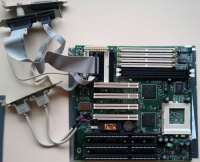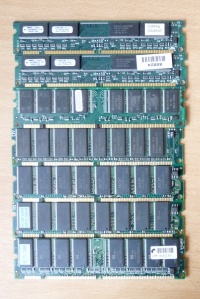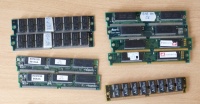Difference between revisions of "Socket 7 Builds"
RacoonRider (talk | contribs) |
RacoonRider (talk | contribs) |
||
| Line 112: | Line 112: | ||
== Choosing RAM == | == Choosing RAM == | ||
[[File:SDRAM.jpg|200px|thumb|Different SDRAM modules]] | [[File:SDRAM.jpg|200px|thumb|Different SDRAM modules]] | ||
| − | [[File: | + | [[File:SIMM72.jpg|200px|thumb|left|72-pin EDO and FPM modules]] |
Depending on the chipset, Socket 7 motherboards support either 72-pin SIMM or SDRAM, or both. | Depending on the chipset, Socket 7 motherboards support either 72-pin SIMM or SDRAM, or both. | ||
Latest revision as of 04:26, 5 April 2013
Socket 7 platform offers late DOS and early Windows games compatibility. Almost anything from 1990 to 1998 can be played at reasonable framerate and with enough comfort.
Contents
[hide]Choosing a CPU
List of supported CPUs
- Intel Pentium (75-200MHz)
- Intel Pentium MMX (166-233MHz)
- AMD K5
- AMD K6 (sometimes K6-2 and K6-III)
- Cyrix 6x86
- idt WinChip, WinChip2
As you can see from the list above, there were plenty of CPUs for Socket 7 platform. However, the CPU of choice is usually either classic Pentium or Pentium MMX. They are better supported by chip set manufacturers (all most common chip sets were also produced by intel) and have good performance. AMD and Cyrix CPUs performance is subject of lots of arguments. WinChip processors were originally designed for low-cost market and though don't perform as well as Pentiums. They have more simple architecture and are closer to 486 and 5x86 rather than Pentium.
Pentium Classic
Classic Socket 7 Pentium CPUs have a wide variety of speeds, ranging from 75 to 200 MHz. They are supported by literally any Socket 7 chipset and proved to be fine performers. Pentium Classic is a good choice for Socket 7 Build, especially for beginners. They are easy to find and cost next to nothing.
See Socket 7 benchmark results for detailed benchmark information
Pentium MMX
Pentium MMX CPUs arrived in 166, 200, 233MHz versions (66MHz x2.5, x3.0, x3.5).
Comparing to Pentium Classic, they have different core (P55C) with lesser 0.28 µm process. L1 cache was doubled (32KB vs 16KB). A new set of instructions called MultiMedia eXtensions was introduced, although the software to use them started to appear only by the time Pentium MMX processors were severely outdated.
Pentium MMX processors are supported by later Socket 7 motherboards with split rail voltage. Not every motherboard will accept such a CPU.
Overall Pentium MMX 233 can be considered the best choice of authentic CPU for a socket 7 system. When overclocked to 262MHz or further, it provides exceptional performance no other Socket 7 CPU can match. However, Super7 CPUs like K6-2 and K6-III still outperform Pentium MMX.
Pentium MMX CPUs are harder to find than classic Pentiums, but they are still quite cheap.
Overclocking
Disclaimer: Author does not take any responsibility for any damage caused by you in the course of overclocking.
Pentium MMX are known to work fine over clock. For that purpose 233MHz version should be used, as most 166 and 200MHz versions have locked multipliers. On a solid motherboard most Pentium MMX can work fine on bus speeds 60, 66, 75 or even 83 MHz (see table). However, RAM and PCI bus might not cope with 83 MHz FSB.
| FSB | x2.5 | x3.0 | x3.5 |
|---|---|---|---|
| 60MHz | 150MHz | 180MHz | 210MHz |
| 66MHz | 166MHz | 200MHz | 233MHz |
| 75MHz | 188MHz | 225MHz | 262MHz |
| 83MHz | 207MHz | 250MHz | 291MHz |
See Socket 7 benchmark results for detailed benchmark information
Cyrix 6x86
AMD K5
The AMD K5 series for socket 7 reached the market late and was eventually introduced in 1996. The CPU design is a further development of AMD Am29000 RISC CPUs and was AMDs first attempt of an own CPU design in the x86 market. The K5s architecture is much more advanced compared to the Pentium and more related to the 6th generation x86 CPUs like Pentium Pro. These features result in a higher per MHz performance for Integer operations than a Pentium. Therefore AMD used a Pentium rating for K5 CPUs. The FPU is about 25% slower than a Pentium CPU clocked at the K5s P-Rating and does not support MMX. The early K5 series CPUs were produced in 500 nm, had an SSA/5 core and were labelled 5K86. PR120 to PR166 K5s were produced in a 350 nm process, had a 5k86 core and were labelled K5. All K5s use a core voltage of 3.52 V. As the K5s architecture did not scale well with higher clock rates the fastest K5 officially released was the K5 PR166 running at 66x 1.75 = 116 MHz. There are AMD K5 CPUs for 50, 60 and 66 MHz FSB and they use a multiplier translation:
| Board | CPU |
|---|---|
| 1.5x | 1.5x |
| 2.0x | 1.5x |
| 2.5x | 1.75x |
| 3.0x | 2.0x |
The 2.0x CPU multiplier was planned for the K5 PR200 running at 133 MHz that was not released because of new K6 series that arrived at the market at this time.
The K5 is a very compatible alternative to Pentium CPUs for low to mid-range socket 7 systems. On a clock to clock basis it has the best integer performance of any socket 7 CPU.
Choosing a chip set
Intel chip sets
Intel released several chipsets for Socket 7. Compared to the earlier Pentium chipsets these were more reliable and feature packed.
The first chipset released by Intel for socket 7 was the 430FX in 1995, codename Triton I. It introduced a new Southbridge chip called PCI IDE ISA Xcelerator - PIIX that included the functionality of several common I/O interfaces, including a PCI to ISA bridge and an integrated Dual Channel IDE controller. The 430FX chipset caches up to 64 MB DRAM and supports PCI 2.0. For later Pentium MMX CPUs 430FX based boards usually require a separate voltage regulator plugged.
In 1996 the Triton II chipset 430HX followed. It was targeted for professional users, supported tighter memory timings, SMP and is able to cache up to 512 MB. This usually requires a Tag-RAM upgrade. It features an updated PIIX3 southbridge, that has PCI 2.1, USB 1.0, Busmaster DMA support for IDE transfers and independent IDE drive timings. Due to the lack of USB devices at this time board manufacturer often left the USB connector unsoldered.
The consumer version of the Triton II chipset was introduced at the same time and called 430VX. While it also used the PIIX3 southbridge, it did not support SMP and could only cache up to 64 MB. The main difference is the support for SDRAM.
Finally in 1997 Intel released its last chipset for the socket 7 platform, the 430TX. The chipset was consumer oriented and supported FPM/EDO/SDRAM while still keeping the cacheable area at max. 64 MB. The southbridge got replaced by PIIX4 that added ACPI and UDMA/33 for IDE.
Overall all Intel chipsets are easy to setup and supported directly by Windows98 up to Windows XP. Later chipsets offer better performance on average due to increased internal buffers. If more than 64 MB should be equipped the 430HX chipset sticks out as the only option where the RAM is covered by the L2 cache. The speed gain from using SDRAM compared to EDO is in the range of a few percent, same goes for the upgrade from 256 kB pipelined burst cache to 512 kB by using a COAST module. As Intel left the Socket 7 platform with Pentium 233 MMX all chipsets support a max. FSB of 66 MHz maximum. Board manufacturers often offered higher multipliers for CPUs that allow to use faster CPUs like a AMD K6 on these chipsets. Of course higher power consumption of faster CPUs should be considered, since a lot of boards with Intel chipsets use simple linear voltage regulators.
It's a common mistake to load up 430FX, 430VX and 430TX chip sets with maximum amount of memory supported by the chipset. With these chip sets, the use of more than 64MB of RAM results in a significant performance drop, as memory bandwidth over 64MB is considerably reduced resulting in about 40% system performance compared to working with L2-cached RAM. To avoid this, either remove extra RAM, or change motherboard for a 430HX based one. If specific applications require more RAM, it could be worthwhile to cover the RAM above 64 MB when using DOS by loading a RAM drive to the remaining top memory area. Some chip sets from other manufacturers are also known to cache more than 64 MB RAM.
Other chipsets
Although the vast majority of chipsets of the era were made by intel, other manufacturers, like VIA, ALI, OPTi, SiS and PCchips, etc. also made chipsets for Socket 7 motherboards. Still, intel chipsets are the best choice for a novice enthusiast, since they cause least trouble and offer high performance. There is also much more info about them on the web.
Note that TXPro chipset is not 430TX, but a relabeled SIS5591, while VXPro+ chipset is a relabeled Apollo VPX. TXPro and VXPro+ motherboards were made by the unfamous PCChips manufacturer and are known to have a rather high defect rate. However, if the motherboard you own is stable after all these years, it's probably not defective.
Choosing RAM
Depending on the chipset, Socket 7 motherboards support either 72-pin SIMM or SDRAM, or both.
72-pin SIMM is compatible with most Socket 7 chipsets. There are two major types of 72-pin SIMM: FPM (Fast Page Memory) and EDO (Extended Data Out). FPM memory comes from the era of 486 and is older than EDO. EDO RAM is known to work no more than 5% faster than FPM. Larger EDO modules are also more common than FPM modules of the same size.
SDRAM(Synchronous Dynamic Random Access Memory) has a whole new architecture comparing to EDO. It can be used by 430VX, 430TX, VIA VP3, ALi Aladdin IV, OPTi Viper chipsets. SDRAM gives a slight performance advantage over EDO, but it's main strength is in working with higher bus speeds.
Things to take into consideration when choosing RAM:
- If your board can accept both EDO and SDRAM, use only one type of memory, don't try to mix them. Only few motherboards are capable of working with both EDO and SDRAM simultaneously.
- EDO RAM works at 5V, SDRAM works at 3.3V. There's usually a jumper near memory slots that configures RAM voltage. It's not a good idea to run SDRAM at 5V, it will make the chips run much hotter than expected.
- Last one or two digits on EDO chips indicate RAM speed in nanoseconds, the lesser the better. For example, -60 or -6 is 60ns RAM, -70 or -7 is 70ns RAM. However, one should not try and compare EDO and SDRAM speeds that way.
- Newer SDRAM modules may not be fully supported by older motherboards. See redhill guide, "Single-sided and double-sided RAM" paragraph.
- It's a bad idea exceed cachable RAM limit (64MB for 430FX, 430VX, 430FX; 512MB for 430HX with TAG RAM upgrade)
Choosing a network card
Generally, NICs in retro rigs are needed to copy large pieces of data, mainly *.ISO images from your main PC. They may be used to occasionaly access the internet, although modern internet becomes less and less compatible with retro rigs.
First of all, NIC has to support older PCI versions (mainly 2.0). Second of all, it should be compatible with Windows 98. And, last but not least, it should provide acceptible transfer speed. Some NICs may load CPU more than others, although substantial benchmarking is needed co confirm this point. There is no use for anything better than 100Mpbs in retro rigs, as CPU power bottlenecks the speed, so intel PRO/100 would work just as fine as Intel PRO/1000.
There's a Vogons thread on the matter. According to recommendations of various users, the following NICs are good choices:
- 3Com 3C509 (ISA)
- 3Com 3C905 (PCI)
- Intel Pro/100 (PCI)
- Intel Pro/1000 (PCI)
- Realtek 8139 (PCI)
- Tulip LNE100TX (PCI)
Today NICs are very cheap and fairly easy to find. There are other products, which may work fine, but the ones on the list proved to be fast and compatible.
Things yet to cover:
- AMD K6, K6-2, K6- III CPUS + image: File:AMD_K6-200.jpg|200px|thumb||AMD K6-200
- Choosing a motherboard +image: File:Asus P55T2P4.JPG|200px|thumb||ASUS P55T2P4(430HX)
- Choosing 2D and 3D graphics cards
- Choosing a monitor
- Choosing sound devices
- Choosing storage devices
- Choosing PSU and case
- What to play on a Socket 7 Build?




